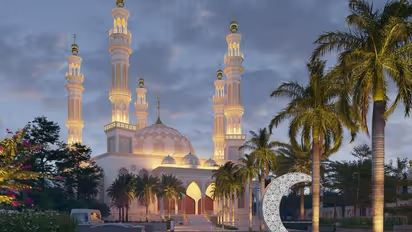Imam from Mecca to lay new Ayodhya mosque's foundation stone; will 'outshine Taj Mahal'

Synopsis
Located 25km from Ayodhya in Dhannipur, this mosque is designed to replace the contentious Babri Masjid, adhering to the Supreme Court's order in the Ayodhya dispute.
The foundation stone for Masjid Muhammad Bin Abdullah, the proposed mosque in Ayodhya, is set to be laid at a distinct location, replacing the Babri Masjid. The honor of laying the foundation stone has been bestowed upon Imam-e-Haram, the revered leader who conducts namaz at the holy mosque within the precincts that house the Kaaba in Mecca. This mosque is strategically positioned in Dhannipur, 25 km from Ayodhya, on a plot allocated by the Uttar Pradesh government in accordance with the Supreme Court's directive in the Ayodhya dispute. The selection of this site symbolizes a collective effort to promote religious inclusivity and harmony.
Haji Arafat Shaikh, a prominent BJP leader based in Mumbai, has been appointed as the chairman of Masjid Muhammad Bin Abdullah's Development Committee. Under his guidance, the mosque is anticipated to become the largest in India, boasting unique features, including the world's largest Quran at 21 feet high and 36 feet wide.
Initially, the Indo-Islamic Cultural Foundation, formed on July 29, 2020, took up the responsibility of constructing the Ayodhya mosque. However, a significant announcement was made in October, during a ceremony attended by senior clerics and foundation chairman Zufar Ahmed Farooqui in Mumbai. The mosque is officially named Masjid Muhammad Bin Abdullah, and a new design, incorporating five minarets symbolizing the five pillars of Islam, was unveiled.
Apart from being a place of worship, the complex surrounding Masjid Muhammad Bin Abdullah is envisioned to serve various community needs. Haji Arafat Shaikh, now also the head of the mosque's development committee, shared plans for a cancer hospital, schools, colleges, a museum, and a library. Notably, the complex will feature a completely vegetarian kitchen, offering free meals to visitors.
One of the highlights of the complex is a massive aquarium near the ablation space, designed with separate sections for men and women. Shaikh asserts that the aesthetic beauty of the mosque will surpass even the renowned Taj Mahal. Additionally, the evening ambiance will be enhanced by fountains coming alive in synchronization with the call for evening namaz. Haji Arafat Shaikh envisions Masjid Muhammad Bin Abdullah as more than just a mosque. It is poised to become a symbol of unity and peace, attracting visitors of all faiths.
“When the evening falls, fountains at the mosque will come alive coinciding with the call for evening namaz,” said Shaikh. “It will be more beautiful than the Taj Mahal and people of all faiths will come to see this monument to peace and harmony even if not all of them will pray here.”
Stay updated with the Breaking News Today and Latest News from across India and around the world. Get real-time updates, in-depth analysis, and comprehensive coverage of India News, World News, Indian Defence News, Kerala News, and Karnataka News. From politics to current affairs, follow every major story as it unfolds. Get real-time updates from IMD on major cities weather forecasts, including Rain alerts, Cyclone warnings, and temperature trends. Download the Asianet News Official App from the Android Play Store and iPhone App Store for accurate and timely news updates anytime, anywhere.